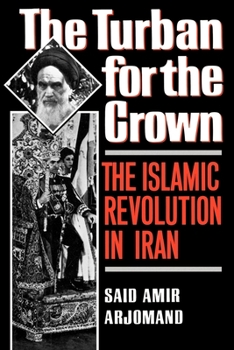Turban for the Crown: The Islamic Revolution in Iran
Select Format
Select Condition 
Book Overview
The Iranian revolution still baffles most Western observers. Few considered the rise of theocracy in a modernized state possible, and fewer thought it might result from a popular revolution. Said Amir Arjomand's The Turban for the Crown provides a thoughtful, painstakingly researched, and intelligible account of the turmoil in Iran which reveals the importance of this singular event for our understanding of revolutions.
Providing crucial historical...
Format:Paperback
Language:English
ISBN:0195042581
ISBN13:9780195042580
Release Date:November 1989
Publisher:Oxford University Press, USA
Length:304 Pages
Weight:1.05 lbs.
Dimensions:0.9" x 5.9" x 9.0"
Customer Reviews
3 ratings
A good look into the Iranian revolution
Published by Thriftbooks.com User , 14 years ago
The book is a very important look into the Iranian revolution. The author does a good job providing the reader enough background into the history of Iran to provide the context for the revolution without bogging the work down with too much detail. The only problem with this is that those already familiar with this history may feel as if much of the information is rehash, but the author here has put that history within the context of the eventual revolution so that the reader can undrestand the currents that took this nation onto a radical new path for both the state and the Shiite religion. The author provides a very detailed account of the relationship between the state and the clerical establishment. What is very interesting is the complex and ever changing nature between the clerics and the state whether they be the Pahlavi's or the constitutional government. There was no hard policy but a give and take depending on where each side saw their interests at any given time. The Shah would sometimes court the religious establishment to help bolster their regime only to turn on them once they were firmly entrenched in power. One of the main things I took away from this book was just how vibrant and fluid Iranian society was. There was so many people pulling in so many different directions that in the end it was this diffusion of power and influence that made it possible for the theocratic revolution to occur. My main criticism of this book is that when the author hones in on the revolutionary period I feel he sacrifices the macro for the micro. He seems to look at the revolution solely from the perspective of something that happened so it was a foregone conlcusion that it would happen. This causes a loss of perspective that ends up minimizing the very real contributions by a plethora of other groups in the overthrow of the Shah, instead his account makes it seem as if this revolution was simply a clerical affair which it very much was not. In some ways this much more narrow focus can be a good thing as long as the reader already has a pretty in depth understanding of the events because it can provide a better perspective as far as the clerical establishment goes, but without that understanding comng into this book the reader can get a distorted picture. The other thing this narrow focus does is ignore some real political realities. One of the things the author does is blame the participants for letting Khomeini take over the revolution. The problem I have is that this doesn't take into account two very real factors at play. One of these is Khomeini's very real political acumen, and the second, which plays into the first, is the eupohoria and the momentum of the events. This momentum allowed Khomeini to become a symbol rather than a flesh and blood man with an agenda, and Khomeini the symbol was amorphous and abstract allowing him to be all things to all people. This is why you would see feminists marching in support of the man. B
Insightful Perspective of the Revolution
Published by Thriftbooks.com User , 22 years ago
The scholar, Said Amir Arjoumand, attempts to elaborate on the inherent ideological causes of the Iranian Revolution. Various other authors I have come across refer to his work and upon reading his book I find his arguments and theories very well written and supported with extensive research and data. It is an illuminating look at what no doubt at the time must have been perceived as a highly unlikely event... the creation of a modern state subservient to Khomeini's unique vision of Islamic law as embodied in his Velayat-e faqih that ultimately destroyed all borders between politics and religion. It is no doubt a work which will prove challenging and perhaps even distasteful to those who come to it with strongly cemented notions of their own, but the scholarship and prose make it a worthwhile read regardless.
An excellent analysis of the Islamic Revolution in Iran
Published by Thriftbooks.com User , 25 years ago
Said Arjomand does an excellent job of showing how it was possible at the end of what is thought of as enlightened 20th century for a group of people dedicated to religious dogma thousand years old to overthrow a modern, centralized state. Arjomand is also right in noting that the Islamic revolution is a prototype for other fundamentalist revolutions that are sure to come in parts of the world and in showing the similarities between secular totalitarian systems, such as Fascism (nationalism+socialism), Communism (classism+socialism) and the Islamic totalitarian system presently in Iran (Islam+socialism). All in all, a must for anyone who wants to understand modern Iran and the Middle East




